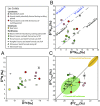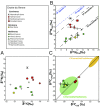Exceptionally high δ15N values in collagen single amino acids confirm Neandertals as high-trophic level carnivores
- PMID: 30782806
- PMCID: PMC6421459
- DOI: 10.1073/pnas.1814087116
Exceptionally high δ15N values in collagen single amino acids confirm Neandertals as high-trophic level carnivores
Abstract
Isotope and archeological analyses of Paleolithic food webs have suggested that Neandertal subsistence relied mainly on the consumption of large herbivores. This conclusion was primarily based on elevated nitrogen isotope ratios in Neandertal bone collagen and has been significantly debated. This discussion relies on the observation that similar high nitrogen isotopes values could also be the result of the consumption of mammoths, young animals, putrid meat, cooked food, freshwater fish, carnivores, or mushrooms. Recently, compound-specific C and N isotope analyses of bone collagen amino acids have been demonstrated to add significantly more information about trophic levels and aquatic food consumption. We undertook single amino acid C and N isotope analysis on two Neandertals, which were characterized by exceptionally high N isotope ratios in their bulk bone or tooth collagen. We report here both C and N isotope ratios on single amino acids of collagen samples for these two Neandertals and associated fauna. The samples come from two sites dating to the Middle to Upper Paleolithic transition period (Les Cottés and Grotte du Renne, France). Our results reinforce the interpretation of Neandertal dietary adaptations as successful top-level carnivores, even after the arrival of modern humans in Europe. They also demonstrate that high δ15N values of bone collagen can solely be explained by mammal meat consumption, as supported by archeological and zooarcheological evidence, without necessarily invoking explanations including the processing of food (cooking, fermenting), the consumption of mammoths or young mammals, or additional (freshwater fish, mushrooms) dietary protein sources.
Keywords: Paleolithic; compound-specific isotope analyses; diet; late Neanderthals; stable isotopes.
Copyright © 2019 the Author(s). Published by PNAS.
Conflict of interest statement
The authors declare no conflict of interest.
Figures




Similar articles
-
A Neandertal dietary conundrum: Insights provided by tooth enamel Zn isotopes from Gabasa, Spain.Proc Natl Acad Sci U S A. 2022 Oct 25;119(43):e2109315119. doi: 10.1073/pnas.2109315119. Epub 2022 Oct 17. Proc Natl Acad Sci U S A. 2022. PMID: 36252021 Free PMC article.
-
Tooth enamel nitrogen isotope composition records trophic position: a tool for reconstructing food webs.Commun Biol. 2023 Apr 7;6(1):373. doi: 10.1038/s42003-023-04744-y. Commun Biol. 2023. PMID: 37029186 Free PMC article.
-
Stable isotope evidence for increasing dietary breadth in the European mid-Upper Paleolithic.Proc Natl Acad Sci U S A. 2001 May 22;98(11):6528-32. doi: 10.1073/pnas.111155298. Proc Natl Acad Sci U S A. 2001. PMID: 11371652 Free PMC article.
-
Importance of accurate trophic level determination by nitrogen isotope of amino acids for trophic magnification studies: A review.Environ Pollut. 2018 Jul;238:677-690. doi: 10.1016/j.envpol.2018.03.045. Epub 2018 Apr 2. Environ Pollut. 2018. PMID: 29621727 Review.
-
[Application of stable isotope techniques in soil food web research].Ying Yong Sheng Tai Xue Bao. 2023 Oct;34(10):2861-2870. doi: 10.13287/j.1001-9332.202310.013. Ying Yong Sheng Tai Xue Bao. 2023. PMID: 37897295 Review. Chinese.
Cited by
-
Saving Old Bones: a non-destructive method for bone collagen prescreening.Sci Rep. 2019 Sep 26;9(1):13928. doi: 10.1038/s41598-019-50443-2. Sci Rep. 2019. PMID: 31558827 Free PMC article.
-
Reconstructing Hominin Diets with Stable Isotope Analysis of Amino Acids: New Perspectives and Future Directions.Bioscience. 2022 May 23;72(7):618-637. doi: 10.1093/biosci/biac028. eCollection 2022 Jul. Bioscience. 2022. PMID: 35769500 Free PMC article.
-
Neanderthals, hypercarnivores, and maggots: Insights from stable nitrogen isotopes.Sci Adv. 2025 Jul 25;11(30):eadt7466. doi: 10.1126/sciadv.adt7466. Epub 2025 Jul 25. Sci Adv. 2025. PMID: 40712029 Free PMC article.
-
Zinc isotopes from archaeological bones provide reliable tropic level information for marine mammals.Commun Biol. 2021 Jun 3;4(1):683. doi: 10.1038/s42003-021-02212-z. Commun Biol. 2021. PMID: 34083709 Free PMC article.
-
Micro Methods for Megafauna: Novel Approaches to Late Quaternary Extinctions and Their Contributions to Faunal Conservation in the Anthropocene.Bioscience. 2019 Nov 1;69(11):877-887. doi: 10.1093/biosci/biz105. Epub 2019 Oct 2. Bioscience. 2019. PMID: 31719710 Free PMC article.
References
-
- Fizet M, et al. Effect of diet, physiology and climate on carbon and nitrogen stable isotopes of collagen in a late Pleistocene anthropic palaeoecosystem: Marillac, Charente, France. J Archaeol Sci. 1995;22:67–79.
-
- Bocherens H, et al. Palaeoenvironmental and palaeodietary implications of isotopic biogeochemistry of last interglacial Neandertal and mammal bones in Scladina Cave (Belgium) J Archaeol Sci. 1999;26:599–607.
-
- Bocherens H. 2011. Diet and ecology of Neandertals: Implications from C and N isotopes. Neandertal Lifeways, Subsistence and Technology, Vertebrate Paleobiology and Paleoanthropology Series (Springer, Dordrecht, The Netherlands), pp 73–85.
-
- Bocherens H, Drucker DG, Billiou D, Patou-Mathis M, Vandermeersch B. Isotopic evidence for diet and subsistence pattern of the Saint-Césaire I Neanderthal: Review and use of a multi-source mixing model. J Hum Evol. 2005;49:71–87. - PubMed
Publication types
MeSH terms
Substances
LinkOut - more resources
Full Text Sources

